Birds, Bouldering, and Blooms
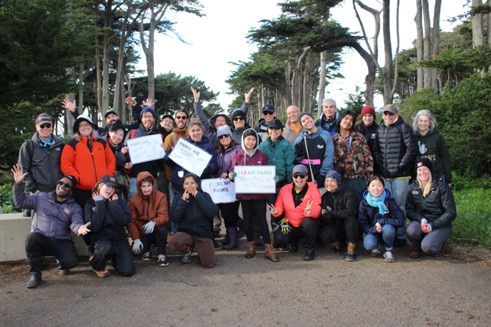
Photo Courtesy Yakuta Poonawalla
Vibrant colors pop
Wildflowers captivate
Spring is here again
The rains finally fell in March, which means our wildflowers have begun
to emerge from their winter rest. We hope to see you all in the field as we
begin our wildflower walks and continue our weekly drop-in programs!
Announcements
Want to become a long-term Steward at Lands End? Read on!
If you love being outside, are interested in
habitat restoration, and want to make a positive impact in your national park, we encourage you to sign up for
our new Lands Ends Volunteer Steward Program!
This volunteer opportunity
is different from our drop-in programs. Volunteers will be trained and be a part
of the
greater National Park Service Volunteer-In-Parks (VIP) Programs. For more information and the
application, please click here.
Checkerspot Butterfly re-introduction at the
Presidio!
Click the link to see the Presidio’s Wildlife Ecologist, Jonathan Young, and
Bio-Science Technician, David Harelson, explain the project.
Events
For a complete list of upcoming events please visit the Presidio Trust and Parks
Conservancy events
homepages!
April 28, 1–4
pm: Lands End Nature Challenge!
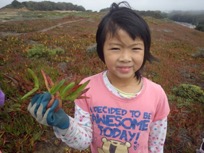
|
|
Photo Courtesy Dominique Sevi
|
Join us for a day of discovery at Lands End, as we search for wildlife together! The Lands End
Nature Challenge is part of The City Nature Challenge, which is an international effort to connect people with the natural
world. This year, there are over 60 competing cities on five continents; the competition is fierce!
Throughout the afternoon, we will talk about all the exciting things we see and hear, as well
as share our insight and excitement for nature. Together, we will take
pictures and document all the wildlife we find, from plants and flowers to
birds, bugs, and fungi! We’ll post our photos on the iNaturalist app, where
plants and animals can be identified by other nature enthusiasts.
All ages
welcome; no experience necessary!
Come be a part
of a diverse community of nature-loving people, as we rediscover our parks
together.
Click the link for more additional details and to register for the event.
For more information, contact Yakuta Poonawalla
at ypoonawalla@parksconservancy.org
May 19, 10 am–1
pm: Fort Funston Nature Challenge!
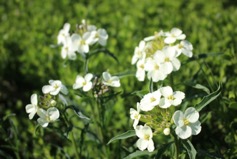
|
|
Photo Courtesy Yakuta Poonawalla
|
Join us for a day of
discovery at Fort Funston, as we search for wildlife together! This area is one
of the last remaining sand dunes in the city, dotted with yellow sand verbena
and seaside daisies. The rare San Francisco wallflower, San Francisco
spineflower, and shy creeping wild rye all make a special appearance here, as
well as the little bank swallow.
Throughout the
morning, we will talk about all the exciting things we see and hear, as well as
share our insight and excitement for nature. Together, we will take
pictures and document all the wildlife we find, from plants and flowers, to
birds, bugs, and fungi! We’ll post our photos to the iNaturalist app, where
plants and animals can be identified by other nature enthusiasts.
All ages
welcome; no experience necessary!
Come be a part
of a diverse community of nature-loving people, as we rediscover our parks
together.
For more information, contact Yakuta Poonawalla
at ypoonawalla@parksconservancy.org
April
15, 11:15 am–12:15 pm: Ohlone Native Plant
Talk
Join Ranger Desiree on a
1.5-mile walk starting from the Presidio Visitor Center to Crissy Field, where visitors will identify native plants
and learn about medicinal plant uses.
April
21, 10 am–12:30 pm: Wildflower Walk at
Fort Funston
The wildflowers are beginning
to bloom in your very own Golden Gate National Parks. We invite you to come and
enjoy the huge variety of both native and exotics on display at Fort Funston
and prepare to be wowed by the range of colors, shapes, and scents!
April
21, 9 am–Noon: Earth Day: Historic
Landscaping at Ocean Beach
Join us at
Ocean Beach for a variety of volunteer activities, including:
Planting along
the historic seawall planter beds, litter removal, painting, and vegetation
pruning!
April Wildlife
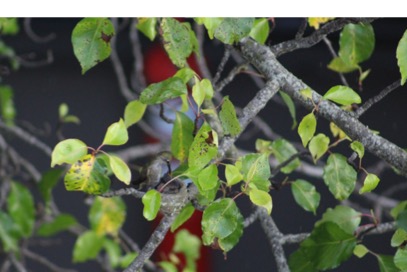
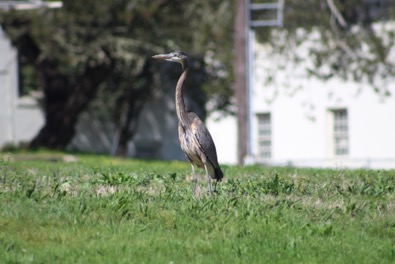
Anna’s
Hummingbird feeding babies & a Great Blue Heron.
Photos
Courtesy Vincent Nicolosi
5 Birds to Observe at Lands End during Spring Migration
By Vincent Nicolosi
Ecological Restoration and Volunteer Management Intern
The Golden Gate National Recreation Area is home
to hundreds of different species of birds, both migratory species and permanent
residents. Lands End provides an optimal opportunity for birdwatching due to
its location on the western edge of San Francisco, jutting out into the Pacific
Ocean. The green space provides a welcome habitat and brief respite for many
birds that migrate through the Bay Area.
Spring migration typically lasts from April through
May. It is a time when resident and migratory birds alike can be found at Lands
End. Below is a list of some of the birds, both common and uncommon, to look
out for in the coming months at Lands End.
1. Hooded Oriole (Icterus cucullatus)
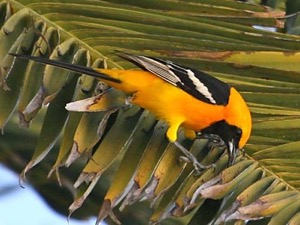
Photo
Courtesy the National Park Service
The
bright orange color of the hooded oriole is a sight to be seen! These birds eat
insects, nectar, and fruits. They also love to build their nests in palm trees.
The hooded oriole was first seen in San Francisco in 1966 and continues to nest
in the area.1 For more information, click here.
2. Forster’s
Tern (Sterna forsteri)
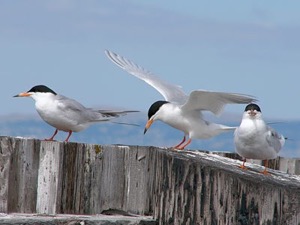
Photo
Courtesy the National Park Service
These birds are often seen offshore and can be
spotted all year long. However, breeding behaviors can be observed in the
spring. A distinctly black cap and black tipped beak are distinguishing
physical characteristics of these commonly seen birds. For more information,
click here.
3. Allen’s
Hummingbird (Selasphorus sasin)

Photo
Courtesy the National Park Service
Not
to be confused with our resident Anna’s hummingbird, the Allen’s hummingbird migrates
to California to mate in the spring months. Like other hummingbirds, male
Allen’s can often be seen trying to impress their female counterparts with
impressive flying patterns. These birds fly upwards in a 25-foot pendulum
pattern, and then dive while producing vocalizations and wing noise.2 For more information, click here.
4. Townsend’s
Warbler (Setophaga townsendi)
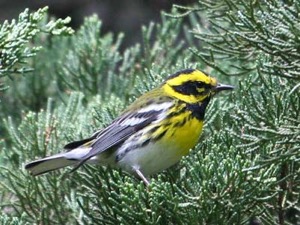
Photo
Courtesy the National Park Service
Spot these insect-eating birds in the cypress
trees at Lands End. The bright yellow head with black markings make the
Townsend’s Warbler an eye-catching bird. These small birds can even live to be
10 years old. Female Townsend’s Warblers have been observed to partially build
a nest in one tree—only to move all the material to a different tree to finish
construction.3 For more
information, click here.
5. Pigeon
Guillemot (Cepphus columba)

Photo
Courtesy the National Park Service
Another one of our visiting water birds, the pigeon
guillemot can be found along rocky shores—just like the coastal landscape of
Lands End! The dark feathers and bright red feet and mouth make for a striking
combination. A white strip can be seen on their wings. The pigeon guillemot has
the ability to dive up to depths of 150 feet when hunting for food!4 For more
information, click here.
Bay Area Bouldering
By Aurora Perez
Ecological Restoration and Volunteer Management Intern
Climbing is a fun,
exciting, and challenging sport for people of all ages and abilities. I first
started climbing a little over two years ago, and it instantly became a passion
of mine. There are different types of climbing, both indoors and outdoors. The
Bay Area is full of beautiful parks to adventure in, with perfect boulders to
climb on.1
Types of Rock
Climbing:
Top roping—this is a
great introduction to rope climbing. It consists of a rope that is passed
through a fixed anchor at the top of a climbing wall or cliff, with each end
tied to the climber and the belayer at the bottom. A top rope (with a watchful
belayer) ensures that the climber is always protected from falling very far,
and is thus a good and safe way to learn to climb.
Sport climbing—this form
of rock climbing uses pre-placed protection, such as bolts or a top rope. This
style of climbing is extremely versatile, offering a range of difficulties as
well as a range of route-lengths.
Traditional or
"trad" climbing—these routes are set traditionally, meaning they do not have fixed
anchors permanently bolted into the wall/crag. Instead, the climber is
responsible for inserting protection into cracks in the rock as they climb up.
Bouldering—this
requires you to leave behind the ropes and harnesses and just climb with shoes
and a bag of chalk over safety mats. The climbs are high enough to be exciting,
but not so high that they're immensely intimidating.
Since I’ve been in
the Bay Area, I have visited a few climbing areas. All beautiful with
spectacular rock. There are boulders all across the North Coast, South Bay, and
East Bay, provided that the rains haven’t made them too slippery.
In the center of San
Francisco there lies a large urban canyon that has incredible spring
wildflowers, miles of trails to hike through, critical habitat for a wide range
of wildlife, and dramatic rock formations to climb! Glen Canyon Park is a perfect, sweet escape from the city’s urban
action.
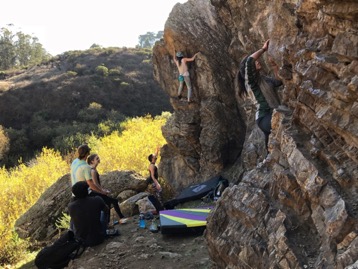
Glen Canyon Park Photo
Courtesy Aurora Perez
The
first place I visited when I moved to San Francisco was the Pacifica Headlands. Overlooking Pacifica Beach and adjacent to Mori
Point, these boulders offer a few bouldering and top-roping opportunities. The
advantage to this location is its proximity to trails and wildflower displays
at Mori Point and the warm sand down at Pacifica Beach. If you are in the area
or looking for something to do when the surf is low, you should definitely
check out this climbing area.
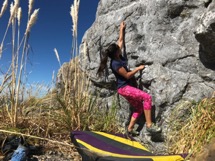 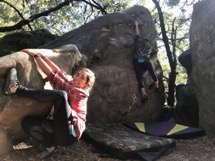
Left: Pacifica
Headlands Right: Castle Rock Photo Courtesy Aurora Perez
If you take a
little longer drive south of San Francisco, you’ll reach Castle
Rock State Park. Known for its beautiful sandstone formations and enchanting, mossy
forest, Castle Rock is home to black oaks, knobcone pines, and high-elevation
coast redwoods. With an extensive trail system of over 34 miles, this park’s
diverse landscapes accommodate a variety of activities, including backpacking,
horseback riding, and rock climbing.2
Castle Rock has
the highest concentration of bouldering routes in the Bay Area, including some
fun sport and trad climbing options, making it the most popular all-around rock
climbing and bouldering venue in the Bay Area.
One of my favorite
bouldering spots near the Bay Area is Nut Tree
Boulders in Vacaville! Locals have been escaping into the
hills to boulder on basalt boulders since the sport began gaining popularity in
the 1970s. It’s a bouldering oasis, filled with lots of grass, beautiful large
oak trees, and random vacas (cattle)
for everyone to enjoy.
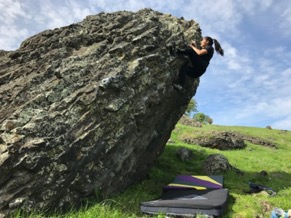
Photo Courtesy Fatima Lopez
When climbing
outdoors, it’s important to recognize our impact on the environment, respect
other visitors’ experience, and think about our actions. The Leave No Trace
program has provided a list of seven principles that encourage us to enjoy our
natural world in a sustainable way.
There are several
steps we can do in order to minimize human-created impacts to our Earth. One
very important step before an adventure is to plan ahead and be prepared. We
should make sure we are aware of any specific regulations or special concerns
for the area we’re visiting.
To help respect
wildlife, we do not follow, approach, or feed animals. Feeding wildlife could
potentially alter the animal’s natural behaviors, expose them to predators, and
damage their health.
Lastly, be
considerate of other visitors. This includes refraining from playing loud
music, overcrowding the climbing area, and leaving a mess behind. For a
complete list of the principles with longer explanations, visit The Leave No Trace Seven Principles page.
Highlights from the Field
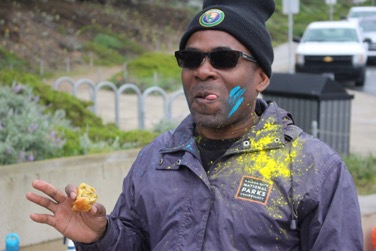
Photo Courtesy Nishad Joshi

- We planted 357 native plants at
Lands End!
- We removed about 45 bags of
weeds from Lands End, 10 bags from the Presidio Coastal Bluffs and 15 bags from
Fort Funston.
- We used our introduced species
to create nature art.
- We ate 50 samosas
provided by KASA during our South Asian Community Program Holi Celebration.
Drop-In Volunteer Programs
|
Volunteer on Thursdays:
Presidio Coastal Bluffs, 1–4 pm
April 5, 12, 19
May 3
Lobos Creek: April
26
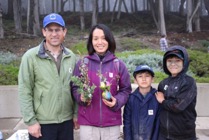
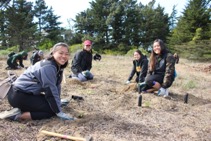
|
Volunteer on Saturdays:
Lands End, 1–4 pm
April 14
May 5
CANCELED:
April 7, 21, 28
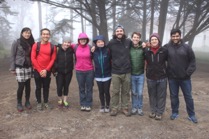

Photos Courtesy
Yakuta Poonawalla & Nishad Joshi
|
|
Click here to find our volunteer work day schedule.
See you in the field!
|

|